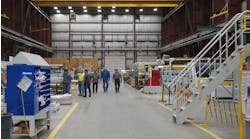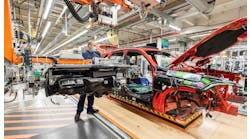As Chinese wages are rising at 17% per year and yuan's value increases, the U.S. is looking pretty good as a place to locate manufacturing plants, according to a new analysis by The Boston Consulting Group.
Add to that flexible work rules and a host of government incentives, and states such as Mississippi, South Carolina, and Alabama, are become attractive low-cost bases for supplying the U.S. market.
"All over China, wages are climbing at 15% to 20% a year because of the supply-and-demand imbalance for skilled labor," said Harold L. Sirkin, a BCG senior partner. "We expect net labor costs for manufacturing in China and the U.S. to converge by around 2015. As a result of the changing economics, youre going to see a lot more products 'Made in the USA' in the next five years.
"Higher productivity, wage rates in Chinese cities such as Shanghai and Tianjin are expected to be about only 30% cheaper than rates in low-cost U.S. states. And since wage rates account for 20% to 30% of a product's total cost, manufacturing in China will be only 10% to 15% cheaper than in the U.S. -- even before inventory and shipping costs are considered. After those costs are factored in, the total cost advantage will drop to single digits or be erased entirely," Sirkin said.
Products that require less labor and are churned out in modest volumes, such as household appliances and construction equipment, are most likely to shift to U.S. production, the group says. Goods that are labor-intensive and produced in high volumes, such as textiles, apparel, and TVs, will likely continue to be made overseas.
A number of companies, especially U.S.-based ones, are already rethinking their production locations and BCG believes that for some companies the economics have already reached a tipping point. The report cites a few examples.
Caterpillar Inc., for example, announced last year the expansion of its U.S. operations with the construction of a new 600,000-square-foot hydraulic excavator manufacturing facility in Victoria, Texas. Once fully operational, the plant is expected to employ more than 500 people and will triple the company's U.S.-based excavator capacity. "Victoria's proximity to our supply base, access to ports and other transportation, as well as the positive business climate in Texas made this the ideal site for this project," said Gary Stampanato, a Caterpillar vice president.
NCR Corp. announced in late 2009 that it was bringing back production of its ATMs to Columbus, Georgia, in order to decrease the time to market, increase internal collaboration, and lower operating costs. And toy manufacturer Wham-O Inc. last year returned 50% of its Frisbee production and its Hula Hoop production from China and Mexico to the U.S.
"Workers and unions are more willing to accept concessions to bring jobs back to the U.S.," noted Michael Zinser, a BCG partner who leads the firm's manufacturing work in the Americas. "Support from state and local governments can tip the balance."
Zinser noted that executives should not make the mistake of comparing the average labor costs for production workers in China and the U.S. when making investment decisions. The costs of Chinese workers are still much cheaper, on average, than comparable U.S. workers, and some managers may assume that China is a better location. But averages can be deceiving.
"If you're just comparing average wages in China against those in the United States, youre looking at the problem in the wrong way," Zinser cautioned. "Average wages dont reflect the real decisions that companies have to make. Averages are historical and based on the country as a whole, not on where you would go today."
"In the U.S., we have highly skilled workers in many of our lower-cost states. By contrast, in the lower-cost regions in China it's actually very hard to find the skilled workers you need to run an effective plant," added Doug Hohner, another BCG partner who focuses on manufacturing.
However it is clear that China will remain a large and important manufacturing location, the consulting group notes. With a huge domestic market companies will still invest in China. Furthermore in the absence of trade barriers that prevent offshoring, Western Europe will continue to rely on China's relatively lower labor rates since the region lacks the flexibility in wages and benefits that the U.S. enjoys, BCG explained. And while other low-cost countries -- such as Vietnam, Thailand, and Indonesia -- will benefit from companies seeking wage rates that are lower than China's, only a portion of the demand for manufacturing will shift from China. Smaller low-cost countries simply lack the supply chain, infrastructure, and labor skills to absorb all of it, Hohner noted.



